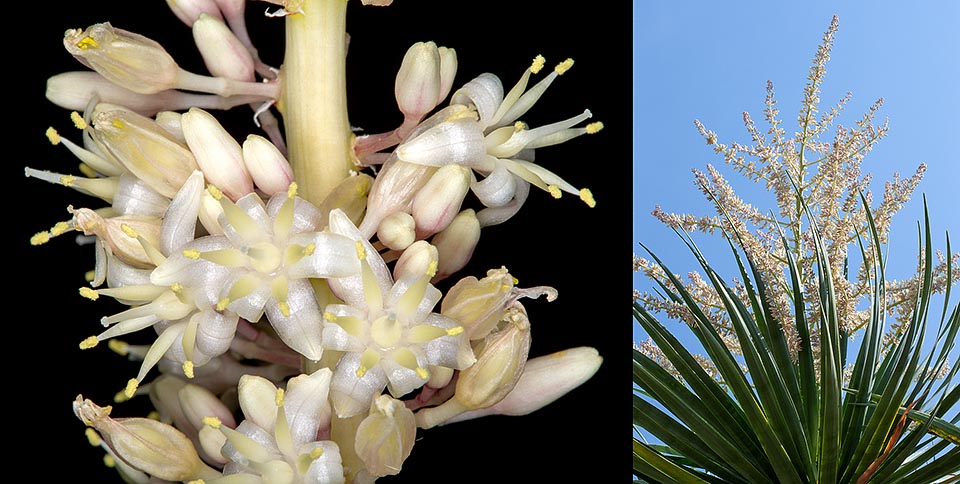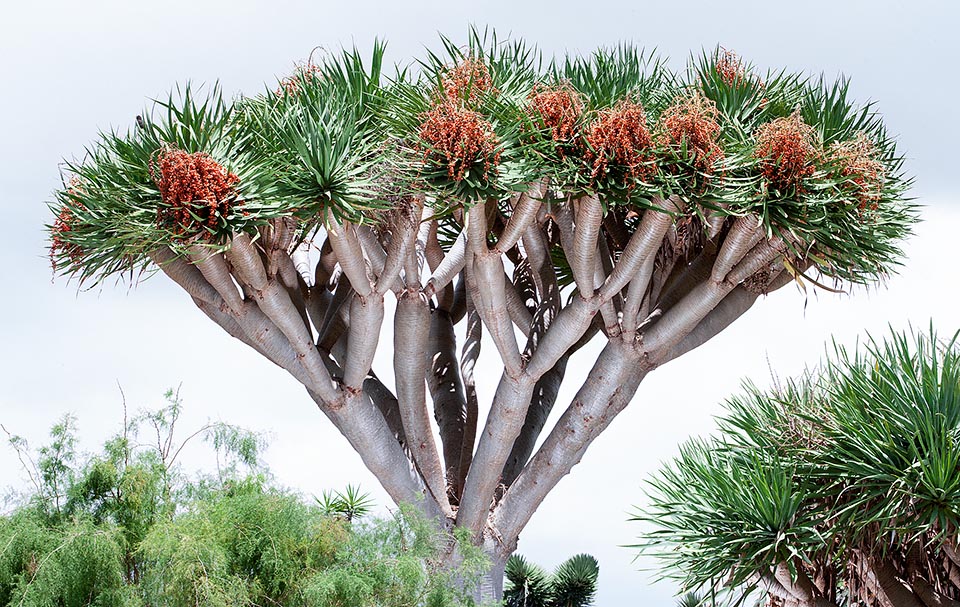Family : Asparagaceae

Text © Pietro Puccio

English translation by Mario Beltramini

Young specimens of Dracaena draco in the Canaries in their environment. The growth is very slow and the species is considered vulnerable in nature © Giuseppe Mazza
The generic name is the Greek substantive “δράκαινα” (drakàina) that is the feminin of dragon; the specific name is the Greek substantive “δράκων” (drakon) = dragon.
Common names: Canary Island dragon tree, dragon’s blood tree, dragon tree (English); long xue shu (Chinese); dragonnier, dragonnier commun, dragonnier des Canaries, dragonnier des îles Canaries (French); albero del drago (Italian); árvore do dragâo, dragão das Canárias, dragoeiro, sangre-de-dragão (Portuguese); drácena de las islas macaronésicas, drago, drago de Canarias, sangre de drago (Spanish); Kanarischer Drachenbaum, Drachenbaum (German).

The tiny night fragrant flowers, with 6 tepals of 8-10 mm, close at dawn. They are merged in panicle terminal inflorescences. The first blooming of Dracaena draco occurs by the tenth year of life of the plant, but in some cases may be considerably delayed. The further blooming follow at 10-20 years intervals © Giuseppe Mazza
It presents on the apexes of the branches dense rosettes of lanceolate leaves with pointed apex and entire margin, of greyish-green colour, orange at the base, coriaceous, up to 60 cm long and about 4 cm broad, forming an umbrella-shaped canopy.
The inflorescences are showy terminal panicles bearing white-greenish fragrant flowers, with 6 tepals, 8-10 mm long, and 6 stamens arranged in two verticils.

From the stem and the notched leaves comes a resin that while drying up in contact with the air gets a dark red colour, known also as “Dragon's blood” © G. Mazza
It usually propagates by seed, previously scarified in order to speed up the germinative process, placed just under the surface in draining sandy loam maintained moderately humid at the temperature of 22-24 °C; the seed needs light for germinating, therefore the sowing vessel is to be placed in a particularly luminous location.
The germination times are fairly variable, from one to three, or even more, months. It can reproduce, even if with a certain difficulty, by air layering or apical cutting in summer.

The fruits are globose red-orange berries, of the diameter of about 15 mm, containing one-two globose seeds of 6-15 mm of diameter © Giuseppe Mazza
It can be cultivated in pot for rather long time, seen the slow growth, in luminous place, caring particularly the drainage of the soil, with regular waterings from spring to autumn, spaced in winter, and monthly fertilizations utilizing a hydrosoluble balanced product.
Sacred plant for the natives of the Canary Islands, the Guanches, due to the particular characteristics of its resin that was used for embalming the dead, has been since the remote times, also outside the origin places, at the centre of legends where they were attributed magic and curative properties.

Millennial specimen at Icod de los Vinos in Tenerife. Various parts of the plant contain bioactive compounds of possible interest for the official pharmacopoeia © G. Mazza
Because of the reduced number of individuals extant in nature, the species has been inserted in the red list of the IUCN (International Union for the Conservation of Nature) as “vulnerable” (species under extinction risk in the wild).
Synonyms: Asparagus draco L. (1762); Draco arbor Garsault (1764); Draco clusii Crantz (1768); Draco dragonalis Crantz (1768); Oedera dragonalis Crantz (1768); Palma draco (L.) Mill. (1768); Stoerkia draco (L.) Crantz (1768); Oedera cranziana Berens (1770); Stoerkia cranziana Berens (1770); Dracaena yucciformis Vand. (1771); Dracaena draco var. strictifolia Hayne (1796); Dracaena draco var. laxifolia Hayne (1809); Dracaena draco var. pendulifolia Hayne (1809); Dracaena draco var. strictifolia Hayne (1809); Dracaena draco var. angustifolia Schult. (1829); Dracaena boerhaavei Ten. (1832); Drakaina draco (L.) Raf. (1838); Yucca draco (L.) Carrière (1859); Draco draco (L.) Linding. (1926).
→ To appreciate the biodiversity within the ASPARAGACEAE family please click here.
